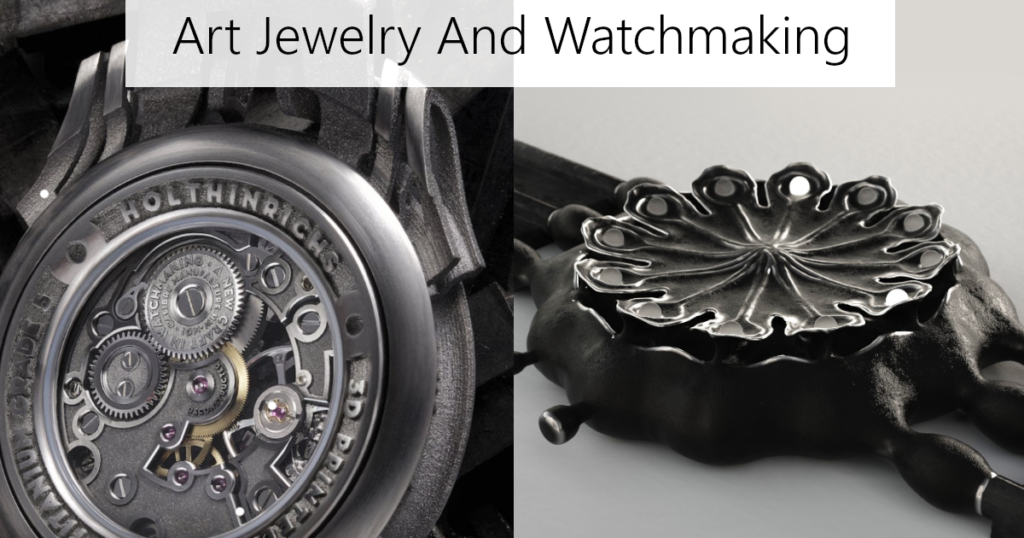
Sections Of This Article
- Basic Concepts
- A Very Brief History Of Jewelry
- The Western Art Tradition Breaks Free From The Single Focus It Had For More Than A Millenium.
- The Evolution Of Art Jewelry
- The Main Influences On Watch Design
- Art Jewelry And Watchmaking: Why Art Jewelry Is Relevant To Contemporary Watch Aesthetics
Introduction
It seems strange to me, as I am beginning to write this, that I can’t find a single article already existing on the subject of art jewelry and watchmaking. By the end of this article you’ll understand why I say it’s strange, because the relationships between the two that I explain here will seem obvious once you read about them.
There are plenty of articles about collaborations between fine artists and watchmakers, also plenty about watches portrayed in fine art, and, of course, the combination of jewelry and watchmaking has existed from near the beginning the evolution of the watch. But the obvious art jewelry influences on contemporary watchmaking seems not to have been noticed before, or at least, not written about much.
I’ll detail exactly why it seems to me that art jewelry based watch design has been inevitable for some time, given the evolution of relevant subjects. And I’ll explain why there are many watches with an obvious influences from art jewelry, and why our own brand, UnconstrainedTime, is arguably the first watch brand based on conceptual art jewelry.
As usual in my blog posts, I’ll be including ideas that are little-known, and sometimes controversial, but I’ll explain them clearly so you can make up your own mind rather than assuming that the accepted views are the only ones available. You can see from UnconstrainedTime watches that I like to think for myself . . . this article is for readers who choose to do likewise.
Note . . . I only use watch images with permission from the watchmaker (unless the photos are public domain or creative commons), so some of the watches I present here might be lacking an image.
Basic Concepts:
To think clearly about the perspectives presented in this article, it’s important to understand the relevant concepts. A lot of people assume they know what they mean when they use words like “art”, but, if you ask for a precise definition, most people will realize that they don’t really have one.
We’ll start with jewelry, because that’s somewhat easier to define . . .
What Is Jewelry?
Jewelry is objects used as decoration or adornment, worn on the body, originating from the word “jewel”, also known as a gemstone, relating to the French word for delight. Jewelry typically uses precious metals such as gold, silver and platinum, and is based on using those materials as settings for jewels.
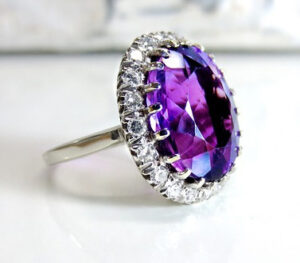
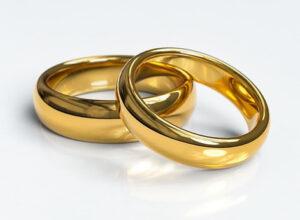
While these days in the “Western world”, the choice of the jewelry one wears would be seen as an expression of individual style, aesthetic preferences and emotional connections, there are still many parts of the world where jewelry has a more practical use, such as in areas of India where one’s personal wealth is still typically worn on the body in the form of gold necklaces etc.
Some jewelry also has cultural meanings, specific ones like symbols of membership of a sub-culture, as well as more general ones like symbolizing status. While it has become part of accepted culture, few people realize that the concept of engagement and wedding rings is mainly the result of marketing by relevant industries.
I’ll explain more about the evolution of jewelry, and how it is now transcending some of its traditional definitions, later in this article.
What Is Art?
This is a more challenging word to define, and is used by different people to mean different things. Advertising adds to this confusion by presenting design as “art,” as is common these days in the jewelry and watch industries, because art is associated with higher status than design.
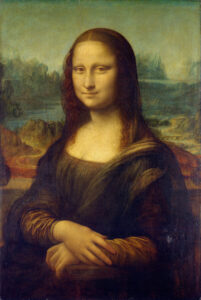
I’ll start with more conventional concepts of what is art, then present a little-known and somewhat controversial perspective on the difference between art and design in the next section.
To put it as clearly as possible: art is creativity relating to conceptual ideas used as a means to communicate, evoke emotions and present challenge perspectives. It also includes the concept of non-utilitarian pleasure, which means that people enjoy art for its own sake, not for it’s practical usefulness as one would with design. Another relevant concept is special focus . . . art presents something as being worthy of unusual attention, unlike most of the experience of everyday life. I’d also add that art is a personal exploration beyond one’s current reality more on that later).
Philosopher and artist, Leo Tolstoy, famously remarked, “Art is not a handicraft, it is the transmission of feeling the artist has experienced.“
A study of art through history reveals that art has a profound relationship to the society the artist is part of. This extends to aesthetics itself, which some might consider to be an absolute, independent of culture, but which is, in reality, strongly influenced by culture. This relationship is illustrated by: a few hundred years ago the ideal examples of beauty being women portrayed in art who more recently would be described objectively as “fuller-figured”, compared to a slim figure being more often portrayed as the ideal of beauty somewhat later in the evolution of art and the cultures it related to:
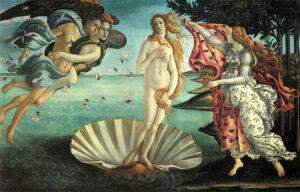

Art often serves as a reflection of societal values, beliefs, and cultural identity. The Tate, a renowned art institution in London, describes art as “a mirror on society,” emphasizing how art captures and interprets the world, offering insights into historical, social, and political contexts.
Art should be distinguished from craft and design. I’ll give a precise, though controversial definition of the difference between art and design, below, but for now, craft is about skilled workmanship (as opposed to mass-production) which can be used either for functional or decorative purposes, and design is primarily about the functionality of the results.
Decorative art, or “applied art” is when art is applied, or added, to functional design:
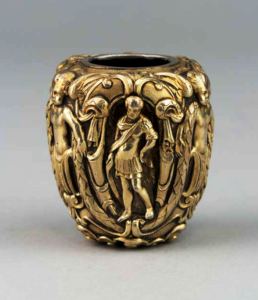
So it’s a combination of the two things. There have been attempts to bridge the gap between art and design, such as Art Nouveau, inspired by the natural world, which flourished across Europe in the decade before and the decade after 1900. While fine art painters such as Klimt have an obvious Art Nouveau influence, the majority of the works produced by the movement are examples of decorative art, although undeniably beautiful ones. In my opinion, the aim of unifying fine art and applied arts resulted instead in a juxtaposition of the two concepts which remained separate. Decorative objects such as Art Nouveau lamps by Tiffany (below) or the posters of Henri de Toulouse-Lautrec being mostly focused on beauty while retaining functionality.
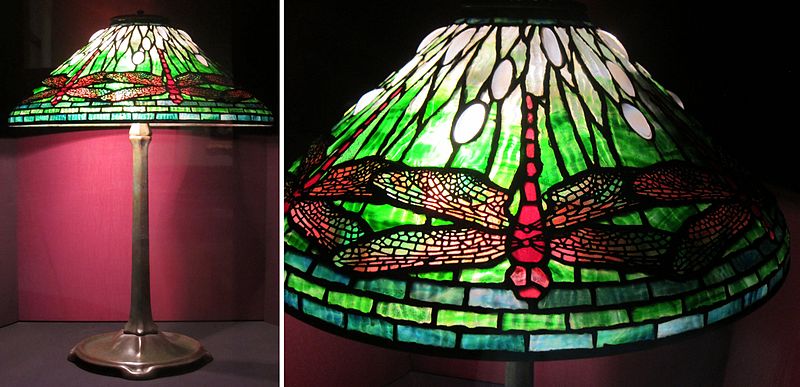
The distinction between art, craft and design lies in their primary focus, though there are inevitable overlaps.
One can see the difference in focus when designed objects are presented as fine art. Examples include Roy Lichtenstein’s use of printed cartoon images enlarged and presented as fine art:

. . . and ‘Fountain’, by Marcel Duchamp which is a standard urinal shown in an art gallery. In both cases, they are design when the focus is on functionality, yet become fine art when presented in such a way that the special focus is on concepts, meaning and evoking responses, rather than functionality, which fits the definitions of the two different concepts.
Which brings us neatly to the next topic . . .
What Is Fine Art?
Fine art is works with a primary focus on aesthetics and concept or story.
It can be seen as a stronger focus on the factors which distinguish art from design and craft and design, so it is used as a means to communicate, evoke emotions and present challenging perspectives, includes non-utilitarian pleasure and a significant degree of special focus.

Fine art often includes painting, sculpture, drawing, limited edition printmaking, and other traditional mediums, as well as newer forms such as digital art and mixed media.
The Getty Museum defines fine art as “creative art, especially visual art, whose products are to be appreciated primarily or solely for their imaginative, aesthetic, or intellectual content.” This definition underscores the emphasis on aesthetic and intellectual value inherent in fine art, transcending mere utility to evoke deeper emotional and intellectual responses from viewers.
By contrast, the design process involves inventing something in your head, then manifesting the results, whether it is product design for functionality, or graphic design which can occasionally be made only to be appreciated visually as art (although usually is for communication).
A little known (and somewhat controversial) perspective is that the fine art process involves finding a subject in the real world, representing that physically in some way oneself, and comparing one’s physical results with that subject, choosing to focus more deeply on what is interesting about the comparison and one’s results, through numerous iterations. What happens when one genuinely does that, is that the results evolve and become somehow more powerful and interesting, leading to something beyond what you could have imagined in your head. It’s hard to comprehend that this might happen if you’ve never done it, especially these days with so many people spending so much of their time involved in thinking and other activities within their own mind.
The fine art process involves creation “from the void” (not from the existing models of reality in your head) which can be profoundly terrifying but can also be very addictive, because it is not only an exploration of the relationship between your internal reality and the outside world, but it also changes who you are, as can be seen from the evolution of the work of any great fine artist. The fine art process applies just as much to abstract art. For example, once it was pointed out to me that the paintings of Rothko are very much landscapes (i.e. relate to objective reality), it was obvious, especially when looking at the originals rather than printed reproductions.
A Very Brief History Of Jewelry
We’ll have a brief look at the history of jewelry because it is directly relevant to the rest of this article.
Ancient civilizations, such as the Egyptians:
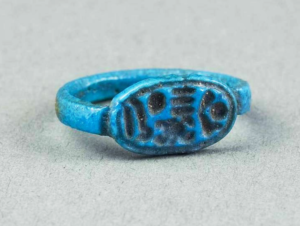
. . . Greeks, and Romans, crafted elaborate jewelry using materials like gold, silver, precious gemstones, and intricate techniques like filigree, granulation, and enameling. For these cultures, jewelry was more than mere adornment; it held religious, social, and spiritual significance.
The art of jewelry-making flourished during the Renaissance, characterized by intricate designs, elaborate gem settings, and a revival of ancient classical motifs. Europe saw a resurgence of craftsmanship, with artisans creating exquisite pieces for royalty and nobility, often incorporating symbolism and heraldry.
The 18th Century saw the origins of fashion or costume jewelry, which are typically made with glass instead of gemstones, and with less expensive materials., but made to look as similar as possible to fine jewelry (below).
The 19th century witnessed significant changes in jewelry design and production. Industrialization introduced mass production techniques, making jewelry more accessible to the burgeoning middle class. Innovations in technology, such as the discovery of new gem deposits and advancements in metalworking, expanded the variety and availability of materials.
Art movements like Art Nouveau and Art Deco in the late 19th and early 20th centuries revolutionized jewelry design. Art Nouveau embraced natural forms, flowing lines, and the use of unconventional materials:
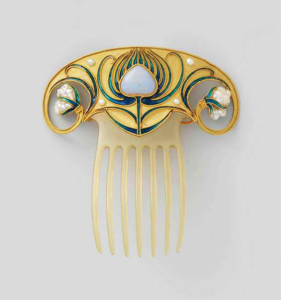
. . . while Art Deco favored geometric shapes, bold colors, and a streamlined aesthetic.
The 20th century witnessed a very significant shift that resulted in a new type of jewelry design, which I’ll explain below.
What is fine jewelry?
I’ll define fine jewelry here, in order to contrast it with a very different type of jewelry I detail below.
Fine jewelry represents an exquisite category of adornments distinguished by its superior craftsmanship, high-quality materials, and often, intrinsic value. Unlike fashion or costume jewelry which uses less valuable materials, fine jewelry is crafted using precious metals such as gold, platinum, or sterling silver, often adorned with genuine gemstones like diamonds, rubies, sapphires, emeralds, and pearls.
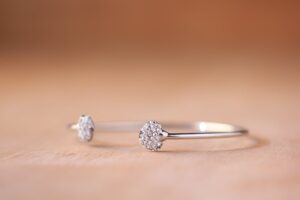
Basically, all jewelry until around the mid 20th Century, and the majority of jewelry since, is either fine jewelry (or fashion/costume jewelry which is designed to look like fine jewelry but made of less expensive materials).
If you look at fine jewelry, you can see that it is almost always based on simple geometric shapes and smooth, polished surfaces. While it would have originally been made by guilds, small workshops or sometimes by individuals, since the industrial revolution, most jewelry is designed by businesses, where the design work is done by a group of people. That is usually still true to some extent, even when the piece is advertised as if it is the artistic creation of an individual working alone.
If it’s of interest, I also wrote in more detail about the history of fine jewelry and its aesthetic influences, here.
The Western Art Tradition Breaks Free From The Single Focus It Had For More Than A Millenium.
While it might not be immediately obvious why this section of the article relates to art jewelry and watchmaking, it is actually an important part of the concept . . .
For well over a thousand years, music was much more focused on notes than sound. This can be seen in the fact that a music manuscript consisting of written notes, is known as the piece of music in question (not as an abbreviation of it which changes what it is).
Until abstract art in the 20th Century, all visual art was focused on objects which have a word for each object, such as people, animals, specific places etc.
These changes around the mid 20th Century, from music focusing on notes to music focusing on sounds that cannot be described as notes, and from art focusing on nameable objects to abstract art (below) focusing on the marks themselves, happened at about the same time, and can both be said to be about the same thing, which is changes from things which have the main focus on concepts which can described by very simple data, to things where the main importance is placed on things which need very much more complex sets of data to represent them effectively.
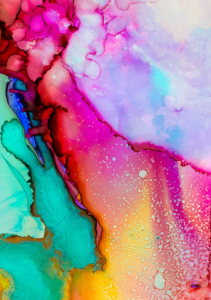
And the same change, at the same time, can be seen in the evolution from fine jewelry (and the costume jewelry which imitated it) which is mainly about simple geometric shapes and smooth polished surfaces, to art jewelry which often uses forms and/or surfaces which are complex, rough, broken, or organic (i.e. much more complex).
This seems to me to be a change from a single system where the focus is on simple symbolic representations, to a focus on the exploration of what is outside that system. In my opinion this could be said to be the biggest revolution in the Western Art Tradition, even though no-one seems to have noticed it!
The Evolution Of Art Jewelry
In the mid-20th century, at around the same time that abstract art appeared and music was undergoing the major change in focus from notes to sounds I described above, a movement emerged that sought to redefine the boundaries of what constituted jewelry. According to the Victoria and Albert Museum, London, this movement was characterized by “a desire to move away from the mainstream and produce innovative, wearable art.” This marked the beginning of the evolution of art jewelry as a distinct form.
Art jewelry represents a fascinating evolution in the realm of adornment, blending artistic expression, innovative techniques, and individual creativity. Its evolution has been marked by a departure from traditional norms and a focus on personal expression and conceptual design.
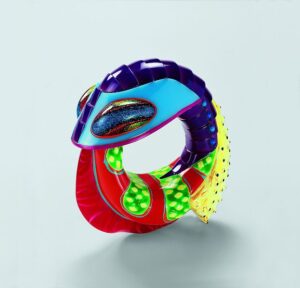
Art jewelry pioneers, like Peter Chang (above), Gijs Bakker, and Wendy Ramshaw, challenged conventional notions by experimenting with unconventional materials, incorporating found objects, and exploring new techniques. Their work aimed to provoke thought, spark conversations, and challenge the traditional standards of beauty and wearability.
The 1960s and 1970s saw a surge in conceptual art and avant-garde movements, influencing jewelry artists to explore ideas beyond the traditional focus. The Smithsonian American Art Museum notes that during this period, artists viewed jewelry “as a medium for personal expression rather than as a decorative accessory.” This mindset shift led to the creation of pieces that conveyed social, political, and philosophical messages, often pushing the boundaries of traditional jewelry norms.
Jewelry artists began using non-precious materials, industrial elements, plastics, and even everyday objects to create unconventional yet thought-provoking pieces. The Art Jewelry Forum describes this as a movement that “redefined jewelry by placing an emphasis on concept over materials, wearability, or preciousness.“
Here are some examples of conceptual art jewelry:
Some areas of art jewelry, such as artisanal craft jewelry, are craft more than art, and represent a recent resurgence of interest in high quality craftsmanship by individuals rather than mass-production. Some art jewelers distance themselves from the word “craft,” which, to some has connotations of amateurism and lack of aspiration. The word “artisan” seems more popular these days.
What could be called conceptual art jewelry (which overlaps with the definition of contemporary jewelry), which is created by an individual as a personal exploration and expression of story or concepts, and valued primarily for aesthetics (unlike fine jewelry which is valued due to materials used) clearly relates to fine art. One commentator said that the only difference between art jewelry and sculpture (an accepted part of the fine art world from the beginning) is the scale, although other writers say that the term “wearable sculpture” is currently being avoided by art jewelers.
Here are some examples of recent art jewelry:
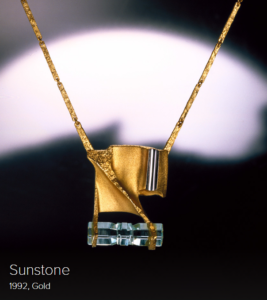
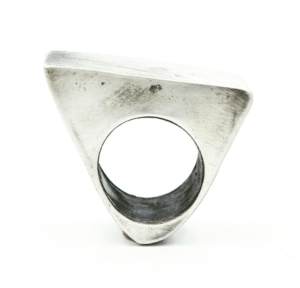
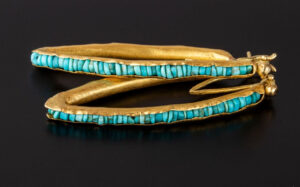
As in most areas, marketing seeks to create false associations to more prestigious realms, such as advertising things as individual creations by “artists” when they are not really that at all. While there are certainly genuine creative artists working in jewelry and watchmaking, creating designs as personal exploration, there are also plenty of mass-produced pieces, being marketed as “art”. So make sure you look at the reality of what things are, rather than what you’re told to believe 🙂
The Main Influences On Watch Design.
Looking at recently made watches, it is obvious that there are two main influences on their design.
One is mechanical engineering, which was the basis of the functionality of watches from the beginning, and is now often used mainly as an impressive achievement in its own right, and to produce visually stunning results. Even with many of the most dramatically interesting and unusual watches today, this is still the main design influence.
The Cartier Rotonde de Cartier Skeleton Mysterious Double Tourbillon:
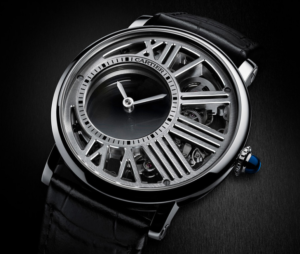
. . . is a beautiful example of creative design with mechanical engineering influences, with its expanded roman numerals and off-center circles concept.
Devon Watches Tread 1:
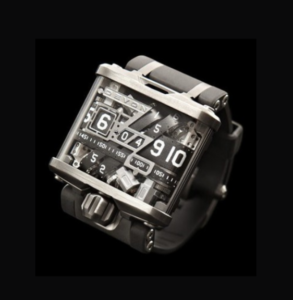
The Devon Tread 1 uses a patented system of interwoven time belts to display the time. It is a fascinating and visually stunning innovation in mechanical time-display, as well as using aerospace-quality materials, and is well known by any enthusiast of contemporary watches both from its technical innovation and from the perspective of the aesthetics.
The Richard Mille RM 70-01 Tourbillon Alain Prost:
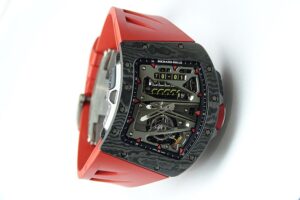
. . . is a great example of creative mechanical design, designed to reflect Alain Prost’s interest in cycling by including their “totaliser” which displays the overall distance traveled on his cycles. Several of the design elements have a bicycle influence, and the case is made of Carbon TPT.
The Christopher Ward Bel Canto:
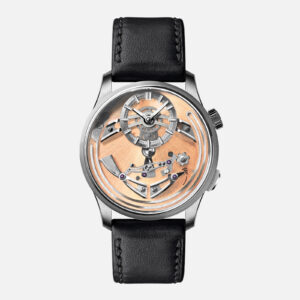
. . . (shown above in Rosa gold) is an unusual looking watch for this brand. Every 60 minutes, to mark the hour, a ‘hammer’ strikes a chime which is a steel spring around the edge of the dial. The Grade-5 titanium case improves the quality of the sound, as well as combining durability with light weight.
The HM9 Sapphire Vision from MB&F:
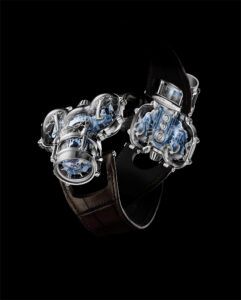
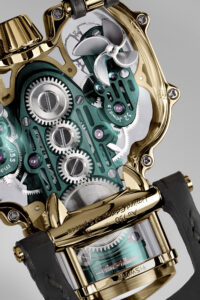
. . . is visually extraordinary as well as being technically impressive, and was made available to the public in four limited editions, with just five pieces each. It was made as “a tribute to the extraordinary automotive and aeronautic designs of the 1940s and 50s. The result was a case like no other that echoed the epoch’s flowing, aerodynamic lines.“
They decided to present their amazing and beautiful movement encased in “an outer hull of sapphire crystal and precious metal.” An outstanding example of engineering presented as an impressive technical achievement by one of the foremost individuals in watchmaking, as well as being a great example of an aesthetic watch.
The Xeric Vendetta X Automatic:
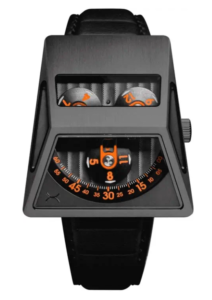
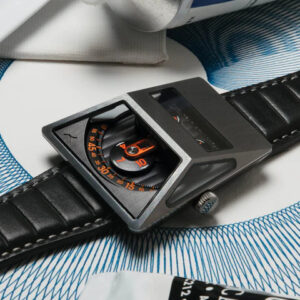
. . . was “born from Mitch’s passion for vintage dystopian science fiction and concept cars of the 70’s like the Lamborghini Countach or Bond’s Lotus Esprit submarine“. It is an outstanding example of creative and visually innovative design, with obvious mechanical engineering influences.
Several of the brands above also have watches which feature in our blog post about unusual watches.
The other main influence on current watch design is fine jewelry. Since watches were, until the industrial revolution, only affordable by relatively wealthy clients, fine jewelry and watchmaking have long had a close relationship, with precious metals and decorative engraving being common in historical watches. It was often the same craftsmen who made jewelry and watches, sometimes for specific reasons, as described in my blog post here on the evolution of the watch. More on the specific influences from fine jewelry, below.
There have, of course, been many other influences on watch design, especially in recent times when the market has increasingly desired innovation and uniqueness as well as concept or story, as cultures and technologies have evolved.
Historical watch design influences include practical considerations, such as the rounded edges and smooth surfaces once watches evolved from being worn around the neck to being kept in pockets, the greater creative freedom when watches moved to the wrist so no longer needed to be round and smooth, and the very influential design of the Cartier Santos, made for practical use by the famous aviator:
In 1904, pioneering Brazilian aviator Alberto Santos-Dumont needed to be able to see his watch without letting go of the controls with his hands in order to time his performances:
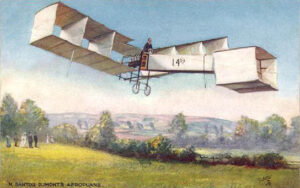
He asked Cartier to find a way to create a watch for his needs, and they designed one to be worn on the left wrist, with what are now called lugs to hold the strap to the case and a clasp to hold it firmly (unlike a slip-on women’s bracelet), a winding mechanism on the right, and a minute hand. They named the model the “Santos”:
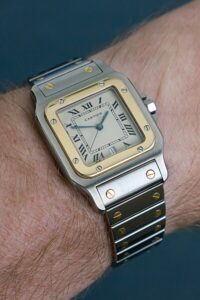
. . . and it has been the basis of the majority of wristwatch designs since that time.
And, of course, there are the space age and digital influences that came along with the use of the 7-segment digital time display.
More recent influences include collaborations with artists, concepts, from other industries such as car makers from Land-rover to Bugatti, to pieces of meteorite, ecological considerations to metal from a historical gun barrel. Some great examples of these fascinating influences and others can be found in my article on what makes some limited edition watches loved and others hated.
Artistic movements have influenced watch design, from the romantic period adding characteristic flourishes, embellishments and jewels to watches, Art Nouveau with its organic curves being one of the factors behind the use of curved Arabic numerals in place of the more traditional straight angular Roman numerals, then the change to simple indexes aligning with the plainer design sensibilities of the Art Deco period.
Fine jewelry has exerted a profound influence on the world of watchmaking, including:
- Design Elegance: Fine jewelry’s emphasis on elegance, sophistication, and aesthetic appeal has influenced watch designs.
- Use of Precious Materials: Fine jewelry’s utilization of precious metals and gemstones, has influenced many watchmakers to employ these luxurious materials in crafting watch cases, dials, and embellishments.
- Craftsmanship and Attention to Detail: The meticulous craftsmanship and attention to detail characteristic of the upper end of the fine jewelry market have set a standard for watchmakers.
- Collaboration with Jewelry Houses: Collaborations between esteemed jewelry houses and watchmaking brands have resulted in exceptional timepieces that blend the expertise and design influences of both worlds.
Here are some examples of the influence of fine jewelry on watchmaking:
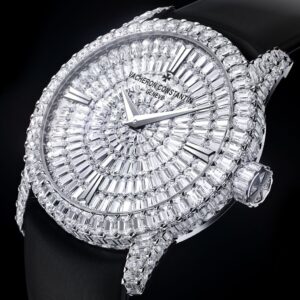
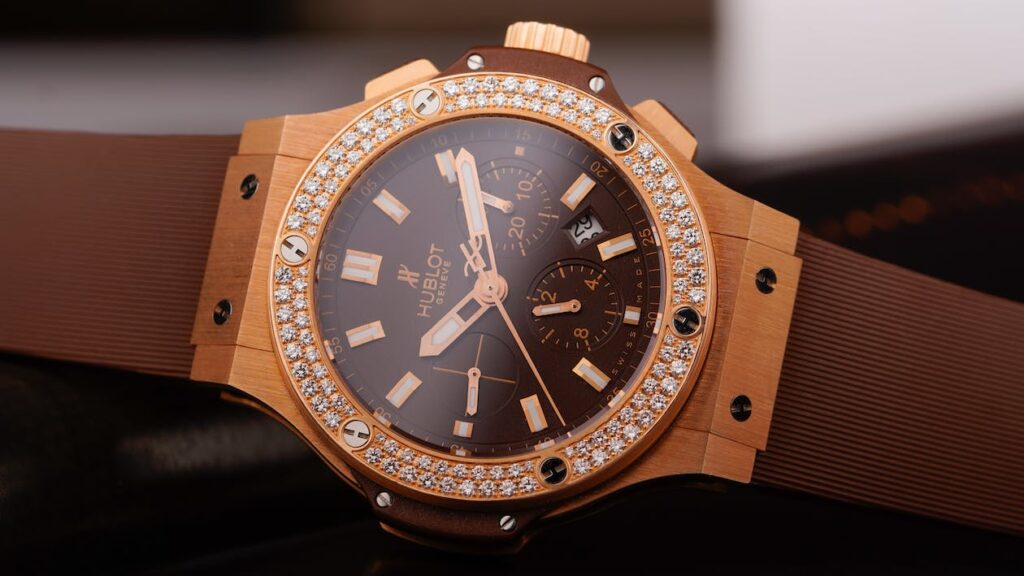
Art Jewelry And Watchmaking: Why Art Jewelry Is Relevant To Contemporary Watch Aesthetics
Art jewelry based watch design has been inevitable for some time now, as art jewelry influences on watch design has increased in various ways that I’ll detail below.
This can be seen in the evolution of watch advertising.
Early watch adverts focus on the properties of fine jewelry such as materials (eg. “18 carat gold”) and mechanical engineering (eg. “key-less lever” or “extraordinary accuracy”).
Many luxury watches are now being advertised as if they have the characteristics of art jewelry such as being created by an individual focusing on chosen aesthetics, being influenced by fine art such as by embodying abstract ideals, and having a significant focus on story or concept.
The jewelry market has already expanded to include art jewelry for more than a century now, and it is an important and growing sector of the market. The watch market is very interested in uniqueness and innovation, and in individual creativity, story and concept, which are characteristics of art jewelry.
Since everyone has the exact time on the smart-phone in their pocket these days, as well as other functions such as alarms and timers, it is easier for this significant new direction in watch design to place less emphasis on the time-display functionality of a watch, allowing much more focus on the watch as an art object and as an expression of the choices made by the wearer.
Art jewelry is already influencing recent watch design in various ways, some of them relatively well known, others much less so.
While not exactly about art jewelry, collaborations between watchmakers and artists have certainly helped blur the lines between fine art, jewelry, and horology, as well as aligning with the market’s desire for uniqueness and watches with a concept or story.
Art jewelry has also helped inspire watch brands to explore unconventional materials. An example are wood watches, which maks sense as coming from the art jewelry perspective on materials, rather than engineering or fine jewelry influences, and also aligns with recent interest in ecological and environmental concepts. The recent fascinating with deliberately patinated bronze watches also makes sense as art jewelry but doesn’t fit fine jewelry or engineering concepts.
Another area of influences from art jewelry (or fine art) which also aligns strongly with the desires of the current watch market are concepts such as personal exploration, uniqueness, concept and story, breaking free from conventions, evoking emotions, presenting challenging perspectives and deserving special focus.
As I detailed above, art jewelry also often uses forms and surfaces not seen in fine jewelry, such as those which are complex, rough, broken, fractal or organic, i.e. much more complex than the very simple geometric forms and smooth polished surfaces used in fine jewelry.
Examples of art jewelry influences on watchmaking include:
The “khumeia” by Simon Pierre Delord, which has a significant influence from Art Nouveau, with conventional watch hands.
The Cartier Crash Tigrée watch has strong art-jewelry influence as well as some fine jewelry influence while retaining conventional watch hands.
The DB28 XP Météorite by De Bethune:
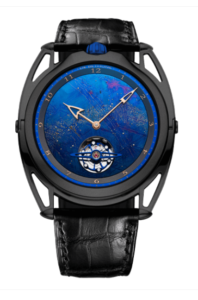
. . . has a beautiful dial with a significant art-jewelry influence of irregular marks, with conventional case and hands.
Blancpain The Great Wave is a gorgeous art-jewelry dial inside a conventional fine jewelry watch case.
Art jewelry influence can also be seen in the way Holthinrichs watches proudly display the rough 3D printed texture on some parts of their watches:
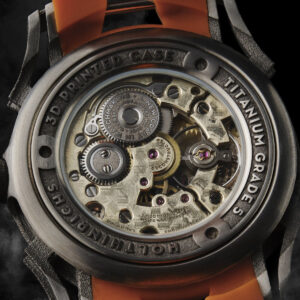
While the beautiful and unique watches above show significant art jewelry influence, they can all be said to be based on conventional watch design, with art jewelry adding a degree of influence. This relates to some aspects of the fascinating question . . . “Are watches art?“
UnconstrainedTime watches:
. . . by contrast, can be seen to be fundamentally arising out of conceptual art jewelry perspectives, with little or no influence from aspects of conventional watch design. Our unique radically simplified time-display frees us from the strong archetypes of watch hands or numerals, allowing much more special focus on the creative aesthetics which convey the concept or story.
The forms we use are often complex, rough, broken, fractal or organic, and we use surfaces such as rough blackened silver, patinas and the raw textured results of 3D printing, as well as materials such as fine woods.
We are not a collaboration between an artist and a watchmaker where the two influences are observably separate, our brand is about watches where the fundamental design of the whole watch is based on personal creative explorations of fascinating concepts or stories. Our watches are very unique, profoundly evocative, and present challenging perspectives such as the 3D fractal used in our Fractal Emergence watch, which, because of the type of fractal it is, can be seen as a 3 dimensional object emerging from 4 dimensional space.
Our watches have little or no influence from the usual watchmaking references, one reason being that I am not starting from being a watchmaker pushing the envelope of watchmaking. My background is in fine art and contemporary music, and my watches are created as a personal exploration of concepts of my relationships with the outside world . . . you can click on any of our watch images below, to read about the fascinating concepts it relates to.
In short, UnconstrainedTime watches are clearly part of the world of conceptual art jewelry, and/or fine art.
That our watches are art is also clear from how aesthetics focused they are. For example, our Fractal Emergence watch (the bronze watch in the center) is based around a 3D fractal, which has zero functionality, it is just to look at, while the time-display does display the time, almost all of that watch (and our other watches) is on aesthetically chosen structures with no functionality.
Don’t miss our launch!
. . . make sure you subscribe to our Priority List for notifications.
Did you know about the art jewelry influences on watchmaking before you read this blog post? I’d be interested to know . . . add your comment below, or on our social media.

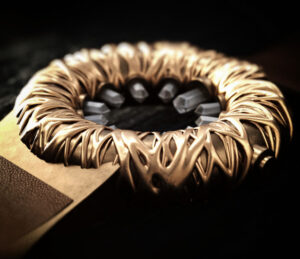
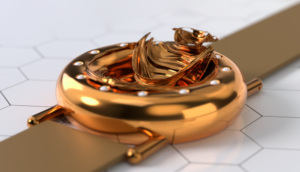
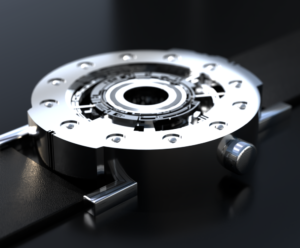
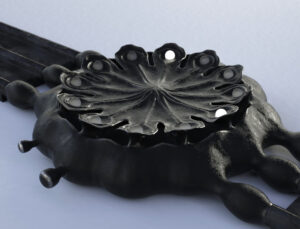
Leave a Reply